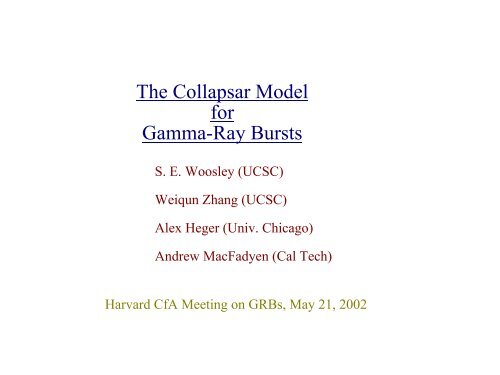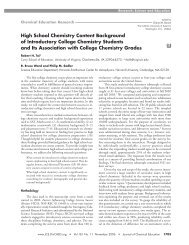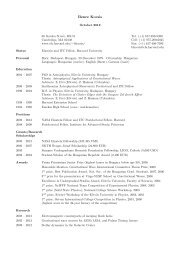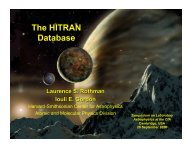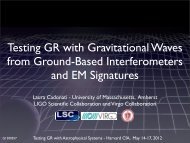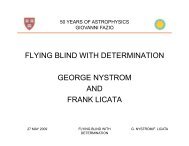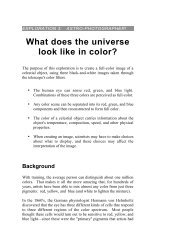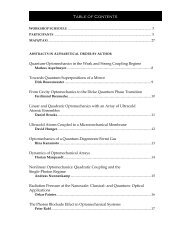The Collapsar Model for Gamma-Ray Bursts
The Collapsar Model for Gamma-Ray Bursts
The Collapsar Model for Gamma-Ray Bursts
Create successful ePaper yourself
Turn your PDF publications into a flip-book with our unique Google optimized e-Paper software.
<strong>The</strong> <strong>Collapsar</strong> <strong>Model</strong><br />
<strong>for</strong><br />
<strong>Gamma</strong>-<strong>Ray</strong> <strong>Bursts</strong><br />
S. E. Woosley (UCSC)<br />
Weiqun Zhang (UCSC)<br />
Alex Heger (Univ. Chicago)<br />
Andrew MacFadyen (Cal Tech)<br />
Harvard CfA Meeting on GRBs, May 21, 2002
Requirements on the Central Engine<br />
and its Immediate Surroundings<br />
(long-soft bursts)<br />
• Provide adequate energy at high Lorentz factor<br />
(Γ > 200; KE ~ 5 x 10 51 erg)<br />
• Collimate the emergent beam to approximately 0.1 radians<br />
• Make bursts in star <strong>for</strong>ming regions<br />
• In the internal shock model, provide a beam<br />
with rapidly variable Lorentz factor<br />
• Allow <strong>for</strong> the observed diversity seen in GRB light curves<br />
• Last approximately 20 s, but much longer in some cases<br />
• Explain diverse events like GRB 980425<br />
• Produce a (Type Ib/c) supernova in some cases<br />
• Make x-ray lines
<strong>Collapsar</strong>s<br />
A rotating massive star whose core collapses to a<br />
black hole and produces an accretion disk.<br />
Type Mass/sun BH Time Scale Distance Comment<br />
I 15-40 He prompt 20 s all z neutrino-dominated disk<br />
II 10-40 He delayed 20 s – 1 hr all z black hole by fall back<br />
III >130 He prompt ~20 s z>10? time dilated, redshifted<br />
*(1+z) very energetic, pair<br />
instability, low Z<br />
Type I is what we are usually talking about.<br />
<strong>The</strong> 40 solar mass limit comes from assuming that all stars above 100 solar<br />
masses on the main sequence are unstable (except Pop III).
Quasar 3C 175 as seen in the radio<br />
Microquasar GPS 1915<br />
in our own Galaxy – time sequence<br />
Quasar 3C273 as seen by the<br />
Chandra x-ray Observatory<br />
Artist’s conception of SS433<br />
based on observations
<strong>Collapsar</strong> Progenitors<br />
Two requirements:<br />
• Core collapse produces a black hole - either<br />
promptly or very shortly thereafter.<br />
• Sufficient angular momentum exists to <strong>for</strong>m a disk<br />
outside the black hole (this virtually guarantees that<br />
the hole is a Kerr hole)<br />
Fryer, ApJ, 522, 413, (1999)
Black hole <strong>for</strong>mation may be unavoidable <strong>for</strong> low metallicity<br />
Solar<br />
metallicity<br />
Low<br />
metallicity<br />
With decreasing metallicity, the binding<br />
energy of the core and the size of the<br />
silicon core both increase, making<br />
black hole <strong>for</strong>mation more likely at<br />
low metallicity.<br />
Woosley, Heger, & Weaver, RMP, (2002)
<strong>The</strong> more difficult problem is the angular momentum. This<br />
is a problem shared by all current GRB models that invoke<br />
massive stars...<br />
15 solar mass helium core born rotating rigidly at f times break up<br />
In the absence of mass loss<br />
and magnetic fields, there would<br />
be abundant progenitors.<br />
Un<strong>for</strong>tunately nature has both.
note models “a-d” (with<br />
B-fields) and “e” (without)<br />
*<br />
Heger, Woosley, & Spruit<br />
in prep. <strong>for</strong> ApJ<br />
Spruit, (2001), A&A,<br />
381, 923
followed here<br />
15 M Helium Star<br />
<br />
Heger and Woosley (2002) using prescription <strong>for</strong> magnetic<br />
torques from Spruit (2001)<br />
.
Some implications ....<br />
• <strong>The</strong> production of GRBs may be favored in metaldeficient<br />
regions, either at high red shift or<br />
in small galaxies (like the SMC). <strong>The</strong> metallicitydependence<br />
of mass loss rates <strong>for</strong> RSGs is an<br />
important source of uncertainty. (Kudritzsky (2000);<br />
Vink, de Koters, & Lamers A&A, 369, 574, (2001))<br />
• But below some metallicity Z about, 0.1, single<br />
massive stars will not make GRBs because they<br />
do not lose their hydrogen envelope.<br />
• GRBs may there<strong>for</strong>e not track the total star<br />
<strong>for</strong>mation rate, but of some special set of stars<br />
with an appreciable evolutionary correction.
Progenitor Winds<br />
Massive Wolf-<strong>Ray</strong>et stars – during helium burning -<br />
are known to have large mass loss rates, approximately<br />
10 -5 solar masses/yr or more.<br />
This wind may be clumpy and anisotropic and its<br />
metallicity dependence is uncertain.<br />
<strong>The</strong> density dependence of matter around a single star<br />
in vacuum could be approximately 1000 (10 16 cm/R) 2 cm -3<br />
composed of carbon, oxygen, and helium, BUT<br />
During approximately the last ~100 – 1000 years of its<br />
life, the star burns carbon (mainly) and heavier fuels.<br />
<strong>The</strong> mass loss rate of the star during these stages is<br />
unknown. No WR star has ever knowingly been observed<br />
in such a state. This means that the mass distribution<br />
inside ~ 10 17 -10 18 cm is unknown (100 yrs at 1000 km/s).
Given the necessary angular momentum, black<br />
hole <strong>for</strong>mation is accompanied by disk <strong>for</strong>mation...
<strong>The</strong> Star Collapses (log j > 16.5)<br />
alpha = 0.1 alpha = 0.001<br />
Neutrino flux high<br />
7.6 s 7.5 s<br />
Neutrino flux low<br />
MacFadyen & Woosley ApJ, 524, 262, (1999)
7.6 s after core collapse; high viscosity case.<br />
In the vicinity of the rotational<br />
axis of the black hole, by a<br />
variety of possible processes,<br />
energy is deposited.<br />
It is good to have an energy<br />
deposition mechanism that<br />
proceeds independently of the<br />
density and gives the jet some<br />
initial momentum along the<br />
axis
<strong>The</strong> Neutrino-Powered <strong>Model</strong> (Type I <strong>Collapsar</strong> Only)<br />
a=0.5<br />
Optimistic<br />
nu-deposition<br />
a=0.5<br />
MacFadyen & Woosley (1999)<br />
a=0<br />
Given the rather modest energy needs<br />
of current central engines (3 x 10 51 erg?)<br />
the neutrino-powered model is still<br />
quite viable and has the advantage<br />
of being calculable.<br />
A definitive calculation of the neutrino<br />
transport coupled to a realistic multidimensional<br />
hydrodynamical model<br />
is still lacking.<br />
Neutrino annihilation energy<br />
deposition rate (erg cm –3 s -1 )<br />
Fryer (1998)
a ≈1<br />
MHD Energy Extraction<br />
From the rotational energy of the black hole:<br />
50 -1<br />
But only need ~ 4 10 erg s !<br />
Bland<strong>for</strong>d & Znajek (1977)<br />
Koide et al. (2001)<br />
etc.<br />
2<br />
2<br />
B ⎛ 2 52 2 M ⎞ -1<br />
rSc 15 ⎜ ⎟<br />
µ o<br />
10 M<br />
E ~ 0.4 ~ 4 x 10 B erg s<br />
⎝ ⎠<br />
x<br />
<strong>The</strong> efficiencies <strong>for</strong> converting accreted matter to<br />
energy need not be large. B ~ 10 14 –10 15 gauss<br />
<strong>for</strong> a 3 solar mass black hole. Well below equipartition<br />
in the disk.<br />
Eventually shuts off when M <br />
can no longer sustain<br />
such a large B-field.
Jet Initiation - 1<br />
<strong>The</strong> jet is initially collimated<br />
by the density gradient left<br />
by the accretion.<br />
It will not start until the<br />
ram pressure has declined<br />
below a critical value.
High disk viscosity<br />
(7.6 s + 0.6 s)<br />
Jet Initiation -2<br />
Low disk viscosity<br />
(9.4 s + 0.6 s)<br />
MacFadyen, Woosley, & Heger, ApJ, 550, 410, (2001)<br />
(Energy deposition of 1.8 x 10 51 erg/s commenced <strong>for</strong> 0.6 s; opening angle 10 degrees)<br />
log rho = 5 - 11.5
<strong>The</strong> Production of 56 Ni<br />
• Needed to power the light curve of the supernova if<br />
one is to be visible. Need 0.1 to 0.5 solar masses of it.<br />
• A bigger problem than most realize<br />
<strong>The</strong> jet doesn’t do it – too little mass<br />
Forming the black hole depletes the innermost core of heavy elements<br />
Pulsars may have a hard time too if their time scale is > 1 sec<br />
• In the collapsar model the 56 Ni is made by a wind off<br />
of the accretion disk. It’s abundance is related to how much<br />
mass accretes into the hole
<strong>The</strong> disk wind: MacFadyen & Woosley (2001)<br />
Neglecting electron capture in the disk
<strong>The</strong> Jet-Star<br />
Interaction
Relativistic Jet Propagation Through the Star<br />
Zhang, Woosley, & MacFadyen (2002)<br />
Zoom out by 10<br />
480 radial zones<br />
120 angular zones<br />
0 to 30 degrees<br />
80 angular zones<br />
30 to 90 degrees<br />
15’ near axis<br />
Initiate a jet of specified Lorentz factor (here 50), energy flux (here 10 51 erg/s),<br />
and internal energy (here internal E is about equal to kinetic energy), at a given<br />
radius (2000 km) in a given post-collapse (7 s) phase of 15 solar mass helium core<br />
evolved without mass loss assuming an initial rotation rate of 10% Keplerian. <strong>The</strong><br />
stars radius is 8 x 10 10 cm. <strong>The</strong> initial opening angle of the jet is 20 degrees.
Pressure in the same model<br />
<strong>The</strong> pressure in the jet is greater than in the star through<br />
which it propagates.
<strong>The</strong> jet can be divided into three regions: 1) the unshocked jet,<br />
2) the shocked jet, and<br />
3) the jet head.<br />
jet head at<br />
4.0 s<br />
For some time, perhaps the duration of the burst, the jet that<br />
emerges has been shocked and has most of its energy<br />
in the <strong>for</strong>m of internal energy. In<strong>for</strong>mation regarding<br />
the central engine is lost.<br />
Zhang, Woosley, & MacFadyen ApJ, to be submitted
Independent of initial opening angle, the emergent beam<br />
is collimated into a narrow beam with opening less than 5<br />
degrees (see also Aloy et al. 2000)<br />
Initial opening angle 20 degrees; 10 51 erg/s<br />
Initial opening angle 5 degrees; 10 51 erg/s
<strong>The</strong> previous calculation was 2D in spherical coordinates.<br />
This puts all the resolution near the origin and also spends a<br />
lot of zones following the unshocked star.<br />
Repeat using cylindrical coordinates and study the just<br />
the jet’s interactions with finer zoning – but keeping the<br />
same density and temperature structure as in the star<br />
along its rotational axis. Carry 80,000 km = 10% of the star.<br />
150 x 800 zones; zone size 100 km<br />
R i = 2000 km<br />
initial jet radius = 700 km (20 deg at 2000 km)<br />
Γ = 10<br />
E int /KE = 20<br />
50 -1<br />
E <br />
= 5 x10<br />
erg s
Lorentz factor Density
Density structure at 2.2 seconds; inner<br />
80,000 km (star radius is 800,000 km).
Pressure at 2.2 seconds
Lessons Learned<br />
• Even a jet of constant power is strongly modulated<br />
by its passage through the star.<br />
• <strong>The</strong> variations in Lorentz factor and density can<br />
be of order unity.<br />
• An initially collimated jet stays collimated.<br />
• <strong>The</strong>re may be important implications <strong>for</strong> the<br />
light curve – especially its time structure.
<strong>The</strong> Jet Explodes the Star<br />
Continue the spherical calculation <strong>for</strong> a long time, at<br />
least several hundred seconds. See how the star explodes,<br />
the geometry of the supernova, and what is left behind.<br />
8<br />
Inner radius = 2 x 10 cm<br />
12<br />
Outer radius = 10 cm<br />
Γ = 10 <strong>for</strong> 20 seconds then declines to 2 at 1000 sec<br />
<br />
50 -1 47 -1<br />
E =5x 10 erg s declining to 10 erg s at 1000 s<br />
E / KE = 20 declining to 2 at 1000 sec<br />
θ<br />
o<br />
int<br />
=<br />
20 o
Density and radial velocity at 80 s (big picture)
Zoom in by 5...<br />
<strong>The</strong> shock has wrapped around and most of the star is exploding.<br />
Outer layers and material along the axis moves very fast. Most of<br />
the rest has more typical supernova like speeds ~ 3000 – 10,000 km s -1<br />
80 seconds
(Zoom in *100)<br />
t = 80 seconds<br />
Shown on a magnified scale, there is still a lot of<br />
dense low velocity material near the black hole
adial velocity/c<br />
at 240 seconds<br />
<strong>The</strong> shock has wrapped around and the whole star is exploding (initial radius was<br />
less than one tick mark here). A lot of matter in the equatorial plane has not<br />
achieved escape velocity though and will fall back. Continuing polar outflow opens<br />
a channel along the rotational axis.
240 seconds<br />
Caution: Effect of disk wind not included here<br />
By this time the star has expanded<br />
to over ten times its initial radius<br />
the expansion has become<br />
(very approximately) homologous.<br />
Provided outflow continues along<br />
the axis as assumed, an observer<br />
along the axis (i.e., one who saw<br />
a GRB) will look deeper into<br />
the explosion and perhaps see a<br />
bluer supernova with broader<br />
lines (e.g., SN2001ke; Garnavich<br />
et al. 2002).<br />
Continued accretion is occurring in<br />
the equatorial plane.
Spreading of jets after<br />
they exit the star
50 -1<br />
E = 5 x10<br />
erg s high internal energy<br />
Γ= 10 θ = 5degrees<br />
10 seconds 35 seconds<br />
Zhang, Woosley, and MacFadyen (2002)
<strong>The</strong> jet properties are shown<br />
35 seconds after its initiation.<br />
Lines give properties at 6.0,<br />
7.5, and 9.0 x 10 11 cm. At<br />
15 degrees in <strong>Model</strong> W1, the<br />
equivalent isotropic energy<br />
flux is about 10 46 erg s -1<br />
(solid line).
GRB<br />
Γ ∼ 200<br />
5 o , internal shocks<br />
GRB 980425<br />
Hard x-ray bursts<br />
Γ ∼ 10 − 100<br />
30 o , external shocks?<br />
Unusual supernova Γ ∼ 1<br />
(polarization, radio source)<br />
A Unified <strong>Model</strong> <strong>for</strong> Cosmological Transients
Some Conclusions:<br />
• <strong>The</strong> light curves of (long-soft) GRBs may reflect more the<br />
interaction of the jet with the star than the time variability<br />
of the engine itself.<br />
•<strong>The</strong> emergent jet in the collapsar model may still contain a<br />
large fraction of its energy as internal energy. Expansion after<br />
break out of material with Lorentz factor of order 10 can still<br />
give final Lorentz factors over 100.<br />
• Much weaker bursts are expected off axis (GRB 980425?,<br />
x-ray flashes?)<br />
• Jet powered supernovae may have significant equatorial<br />
fall back. Jet may continue with a declining power <strong>for</strong> a<br />
long time<br />
• Circum-burst mass distribution highly uncertain<br />
• 56 Ni synthesis given by disk wind. May be related to<br />
total mass accreted.


